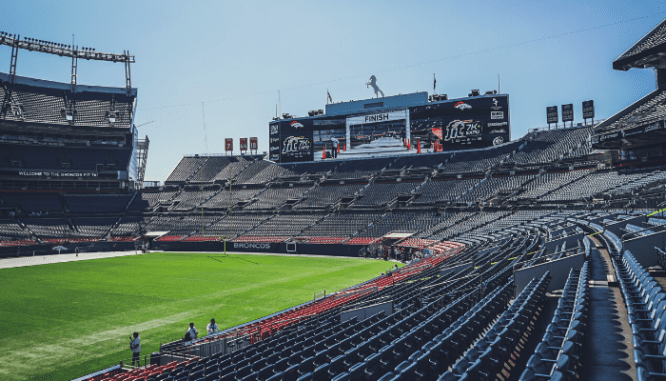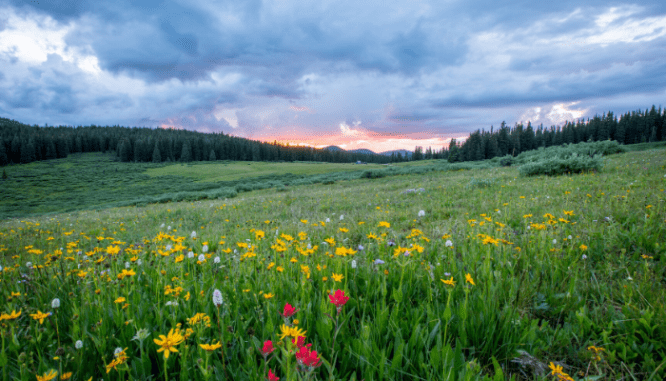Make the Mile-High City Your Forever Home: How to Buy House in Denver
- Published on
- 8-9 min read
-
 Astrid Storey Contributing AuthorClose
Astrid Storey Contributing AuthorClose Astrid Storey Contributing Author
Astrid Storey Contributing AuthorAstrid Storey is originally from Panama and spent most of her early years traveling through Central and South America. She arrived in Denver in 2003, the day after graduating college. During the next decade-and-a-half, she’s juggled a career in a variety of creative and marketing roles while building her own studio, Storey Creative, with clients in real estate, health care, publishing, and tech.
The Mile High City sits at the base of the Rocky Mountains and consistently ranks as one of the best places to live in the United States, according to U.S. News & World Report. People across the country hear the message loud and clear: From 2010 through 2019, Denver’s population has grown an estimated 19.5%, with new residents attracted to a thriving cultural scene, a variety of career opportunities at Fortune 500 companies, and spectacular views year-round.
More than just a single city, the Denver metro area is considered a conurbation consisting of one continuous region across six central counties: Adams, Arapahoe, Broomfield, Denver, Douglas, and Jefferson.
People interested in buying houses for sale in Denver County — what the locals refer to as “Denver proper” — will be looking at a combination of older, smaller, single-family homes in styles like Victorian, Denver Square, Bungalows, Mid-Century Modern or Tudors (depending on the neighborhood)… or more modern, contemporary-style new construction that’s been cropping up closer to the downtown area, with an estimated 10,000 new residential units built or still under construction from 2014 through mid-2019.
There’s also stiff competition from other new residents and Colorado natives who dream of owning a home here. The Denver market remains competitive for buyers throughout the year, which means it’s critical to understand what you’re doing and when to walk away. To help homebuyers prepare, we spoke with Anne Dresser Kocur — a top Denver real estate agent with nearly 40 years’ experience — plus other experts in the area who can help you navigate your home purchase.

Figure out your budget
A great place to start your journey of buying a house in Denver is to visit a Home Affordability Calculator. This tool offers a personalized big-picture view of your finances and the Denver market and provides a range buyers can use to open the conversation with a lender.
Another helpful tool is our step-by-step guide to save up for your dream home, with real-world advice on what you should know about your finances before getting pre-approved for a mortgage.
Single-family home pricing in Denver sits at 91% above the pre-recession 2007 high as of late 2019, hinting at Colorado’s robust economy. According to the Denver Metro Association of Realtors, the median sales price for single-family homes in 2019 was $475,000 — up 2.7% from 2018. The median sales price for townhomes and condos in 2019 was $365,000 — a drop of 1.4% from 2018.

The houses you’ll find in Denver
Many buyers are interested in certain areas of the city because of the architecture style specific to the neighborhood. At a glance:
Victorian houses all offer the asymmetrical fronts, turrets, wrap-around porches, and stained glass you’ll find in Park Hill, Capitol Hill, Cheesman Park, and Highland. Dating between the 1860s and up until the 1910s, these are the oldest homes in the city.
The “Denver Square” is what other areas of the country call a “Foursquare.” These homes became popular after the silver crash that triggered the Panic of 1893, and feature brick construction with matching square footage on the first and second floors. They’re very efficient in their use of space and they are common in most Denver neighborhoods (Capitol Hill, Cheesman Park, City Park, West Highland).
The Classic Cottage is a little more straightforward. Similar in shape to the Denver Square, these homes feature a front porch, hipped roof, and flared eaves that were a trademark of working-class neighborhoods in the first half of the 1900s in Denver. You can find your own classic cottage in Globeville, Highland, Whittier, and West Washington Park.
The classic Denver Bungalow is a one-story cottage, leaning heavily into the Arts and Crafts style of the 1930s. Its efficient floorplans and basement living spaces are a trademark of the Washington Park, Congress Park, Park Hill, and West Highland neighborhoods.
If Tudor is more your taste, these houses — dating from the 1920s and 1930s in Denver — feature casement windows, covered ceilings, oak trim, and steeply pitched roofs. Tudors can be found in Park Hill, Country Club, Bonnie Brae, and Hilltop.
There are about 7,000 mid-century modern homes in Denver, dating from the 1960s, with clusters around Virginia Village, Bonnie Brae, West Washington Park, and Southmoor.
According to Kocur, Denver buyers prefer the houses that have already been updated — if budgets allow. And because of Denver’s penchant for the outdoors, “a lot of buyers are trending toward having an outdoor living space, whether it’s for them for entertaining, family, pets or children.”

Choose the best location for your needs
“Denver is expanding in all the quadrants,” Kocur says.
Downtown Denver
Contains:
- 16th Street Mall
- Pepsi Center
- Coors Field
- The Platte River
- The Downtown Aquarium
- Museums
- World-class hotels
- Denver Union Station
- The Denver Performing Arts Complex
- The Colorado Convention Center
- Historic Lower Downtown (LoDo) with restaurants, art galleries, bars, brewpubs, and coffee houses
- Denver Pavilions
Benefits: Lots of walkability and urban adventures for all ages. Available bike-sharing and scooter-sharing programs are within the city, along with free shuttles up and down 16th Street, and the possibility for travel through the Light Rail system, which provides fast, convenient, and easy access to many areas in the city, even including the Denver International Airport.
Drawbacks: The available residential properties — a mix of luxury condos, converted lofts, and brand-new townhomes — feature small to non-existing outdoor space and if you drive, parking can be difficult and traffic can present a problem when traveling to other places in the city. If you have children, there are no public schools in Downtown Denver, so your child will have to travel outside the area to go to school.

Curtis Park/Five Points
Contains:
- Historic Curtis Park
- The Rossonian Hotel
- Blair-Caldwell African American Research Library
- Welton Street
Benefits: This wedge-shaped neighborhood is located east of Downtown Denver and features some of the oldest homes in the city. There are plenty of residential blocks featuring a combination of old and new constructions. Easy commute to Downtown and connected to the Light Rail system via the Welton Street Station. Lots of locally owned businesses offer the streets of Five Points a charming destination for shopping and dining.
Drawbacks: As a neighborhood in the middle of an ongoing renewal, expect lots of construction-related nuisances like heavy machinery noise. Parking availability varies from block to block. There are available public schools within the neighborhood, but the ratings are not ideal.
City Park West
Contains:
- The Denver Zoo
- The Museum of Nature and Science
- A short distance to Downtown Denver via public transit or urban bike lanes
Benefits: A chill and relaxed vibe with an eclectic mix of people, features both single-family homes with yards and attached homes as well as condos. More greenery than Downtown Denver.
Drawbacks: Not too many conveniences; grocery stores are located outside the neighborhood and parking can also be hit-or-miss depending on the block.
Highland
Benefits: Located northwest of Downtown with easy access to I-25 and I-70 (the mountains), this neighborhood features charming streets and plenty of locally-owned shopping and dining options. Housing inventory consists of new construction lofts and townhomes, as well as renovated homes. Kocur says, “If you’re looking for walkability, I recommend Highland or Sunnyside or some of those areas just north of Downtown, where they can easily get to Union Station and all the bars and restaurants.”
Drawbacks: One of the hottest real estate neighborhoods, parking is flat-out difficult. You will have to travel a few miles into Wheat Ridge or south to Sheridan for amenities like grocery stores or big-box chains. Public schools in the area are also not the best in ratings, so buyers with families will probably want to look at options outside the area.

Cherry Creek
Contains:
- The Cherry Creek Shopping Center
- The Cherry Creek North retail district
- The Cherry Creek Bike Path that connects you to Downtown and the suburbs
- The Denver Botanic Gardens
- Infinity Park
- A selection of high-end hotels
Benefits: A luxury enclave featuring upscale and newer townhomes and updated bungalows; it’s a pedestrian-friendly place with popular bars and dining options. More family-friendly than other areas in Denver, the area is home to great schools both public and private.
Drawbacks: Parking can be hit-or-miss; most available spaces are either metered or belong to paid lots. There are some free spots in residential areas.
Sloan’s Lake
Contains:
- The city’s largest lake: Sloan’s Lake
- A lively calendar of neighborhood events open to the public
- Near Mile High stadium for football fans
Benefits: Very walkable neighborhood with great scenic walking areas around the lake. Parking is easy, and street spots are usually available along residential streets. Eclectic people and eclectic inventory of homes that accommodate anything from couples to families.
Drawbacks: This neighborhood doesn’t have a Light Rail stop, but still offers a few RTD locations for buses and mass transit options.

Washington Park
Contains:
Benefits: Access to 155 acres of park grounds in Washington Park; great shopping and dining options in the Old South Gaylord street neighborhood. Tree-lined streets, access to a rec center, gardens and playgrounds. Popular homes styles include bungalows, Tudors, and “Denver squares” in different degrees of update, as well as new construction. Lots are bigger and many properties feature front and/or backyards. Easy access to Cherry Creek shopping and dining, I-25, and the Denver Tech Center.
Drawbacks: Street parking can be difficult but many homes offer alley-facing garages or off-street parking. There is less walkability, and streets have a tendency to be congested every day of the week.
Capitol Hill and Golden Triangle
Contains:
- Colorado State Capitol
- Civic Center Park
- The Molly Brown House Museum
Benefits: Stately homes converted into smaller living quarters. A younger, eclectic demographic. Nightlife, dining, and bar options make it a destination with lots of foot traffic. Easy access to Downtown and I-25, as well as public transportation.
Drawbacks: Not really a family neighborhood. Parking can be difficult to find. Some blocks only offer metered parking or parking lots as an option.
Belmar/Lakewood
Contains:
- A central plaza with coffee shops, a movie theater, art galleries, a bowling alley, and retail options
- Lakewood Cultural Center
- 40 West Arts
Benefits: Many buyers are attracted to the West side because it’s close to the ski areas, with easy access to C-470 and I-70. There are golfing-adjacent communities, and a combination of older 1940s construction and newer homes. Parking is plentiful and readily available in both main and residential streets.
Drawbacks: Not as much walkability; you’ll probably need a car to move around.
Green Valley Ranch
Contains:
Benefits: Convenient and easy access to DIA, open spaces, and hiking, as well as a state-of-the-art rec center. A uniquely suburban feel within the City of Denver, Green Valley Ranch is surrounded by open space while still having access to two different Light Rail stops. Available homes are a combination of newer single-family homes, townhomes, and condos.
Drawbacks: You will need a car to move around.
Stapleton/Lowry/Northfield
Contains:
Benefits: A suburban feel within a close distance to the city’s attractions. A combination of master planned communities built on a reclaimed Air Force base, turned into a well-planned enclave with a variety of retail shops, grocery stores, and open space. Direct access to I-70 and I-225. Provides the best family-friendly living within a short distance from Downtown Denver.
Drawbacks: You will need a car to move around.

Tips for buyers
Denver design trends
Buyers are still requesting grays and whites for interior paint colors, and hardwood or laminate floors that look like hardwood. Open floor plans remain popular, and even though the housing stock is older, a lot of homeowners have remodeled to remove interior walls. It’s possible to get a nice Craftsman home in Washington Park or turn-of-the-century cottage around City Park that’s been fully updated inside.
If you’re looking for outdoor space in the city, rooftop decks are becoming very popular in areas with new construction, such as Sloan’s Lake, Highland, RiNo, and City Park.
“The primary trend in Denver over the last three years is homeowners looking for three-season outdoor living spaces, and it’s because we have so much nice weather here in the metro area, and very few bugs,” according to Wendy Booth, President of Ivy Street Design, a local award-winning landscape architecture firm. “Homeowners are looking at fire features — like fireplaces and firepits — built-in BBQ grills and smokers as well as full outdoor kitchens, shade structures, and self-contained water features.”
The best season to buy
“Sellers are more motivated going into the winter months, but there’s more inventory between March and June,” according to Kocur. So if you want the best bang for your buck, look in the winter months. However, if what you seek is variety, it might be worth it to wait until the spring and early summer to allow for more options to hit the market at the same time.
“Houses are still going fast in that $300,000 to $500,000 range, and even higher when they’re priced right,” Kocur adds. With an average of 100 deals a year, she recommends taking into account days on market, how many price reductions there have been (if any), and what the seller’s motivation is before making an offer.
What to inspect in the inspection
About 43% of Denver homes are more than 50 years old, and even though Colorado enjoys an average of 300 partially sunny days a year, it does also have the second-highest number of hail claims in the United States between 2016 and 2018, second only to Texas.
Kocur recommends making sure the roof and gutters are carefully inspected for hail damage. Radon is also very common, and sometimes drainage can be an issue with foundations.
“When I sell houses, the three major inspections I recommend are radon, sewer scope, and foundations,” Anne says. “It’s also very common to have soil issues that aren’t necessarily structural, but it’s common for driveways, garages, and walkways to crack and require mudjacking repairs. A lot of people coming from out-of-state aren’t used to radon, so I educate them about the EPA standards. When the test comes over 4.0, we recommend they request a radon mitigation system.
“Gas-forced air heat is the most common, and I would say the majority of homes do have AC or at least a swamp cooler, except for the very old homes,” she adds.
Getting the offer accepted
“One thing I’ve noticed from people coming from other regions is to get a homebuyer’s warranty, which covers plumbing, heating, electrical. In Colorado, that’s not a standard contract provision,” Anne says. This is a great negotiation point when you’re trying to make your offer attractive to a seller.
Working with a HomeLight top real estate agent means shoppers can buy a Denver home for around 89.7% of the list price, instead of the average 95.9% closing the average agent gets. If you want to add that perfect entertaining outdoor space to your chosen Mile High home, a top Denver agent will be able to save you an average of $25,510, which will have you well on your way to a dream landscape.
Header Image Source: (Fredrikande / Shutterstock)
